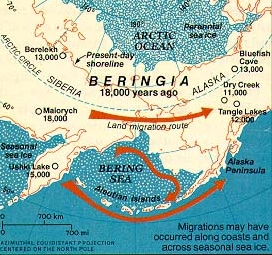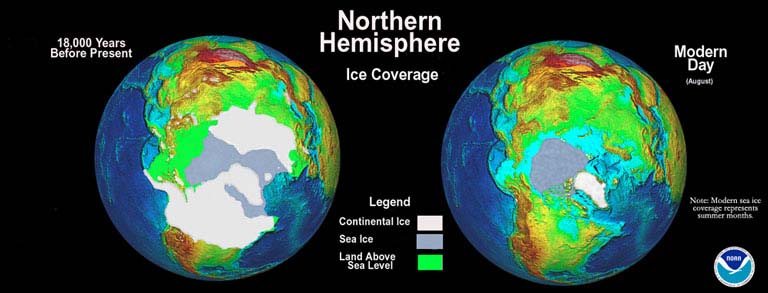Throughout much of the earth's history, long before humanity came onto the scene (from say 2,000 million years ago to 2 million years ago), the global climate was much warmer than now, with the global mean temperature as much as 8°C to 15°C warmer than it is today. During most of this time, the polar regions were free of ice. For example, during the mid-Cretaceous Period, around 100 million years ago, lush ferns and alligators resided in what is now Siberia. Dinosaur skeletons have been recovered from north of the Arctic circle in Alaska. These and other pieces of evidence indicate that the mid-Cretaceous climate was on the order of 3-11°F (1.6 - 6.1°C) warmer at the equator and 30-110°F (16 - 61°C) warmer at the poles compared to the present with no permanent polar ice caps.
These comparative warm conditions, however, were interrupted by several periods of glaciation. Geologic evidence suggests that one glacial period occurred about 700 million years ago (or million years before present, MyBP) and another 300 MyBP.
The most recent glacial period — the Pleistocene Epoch — began about 2 MyBP (2 Million years Before Present).
About 2 MyBP, continental glaciers appeared in the Northern Hemisphere, marking the beginning of the Pleistocene epoch. The Pleistocene, however, was not a period of continuous glaciation but a time when glaciers alternately advanced and retreated (melted back) over large portions of North America and Europe.
The Pleistocene experienced the most important single environmental event since the human species has been on Earth: The oscillation between glaciation and interglacial periods. The Pleistocene Epoch is remarkable not just for the alternation of warm and cold phases but for the scale and rapidity of the changes. There were at least 20 glacial/interglacial cycles during the Pleistocene.
You should realize that an Ice Age does not mean the entire Earth is a frozen snowball. During the lead up to an Ice Age, there is more accumulation of ice each year than melt off. This results in glaciers spreading southward from the north pole. Over a period of many years, the glaciers can extend as far south as the northern parts of the United States, but do not reach into the tropics. In fact the tropics are probably still warm during ice ages. Scoll down to the figure below showing the coverage of ice at the peak of the last ice age.
 Figure 2. Alaska and Siberia and the Bering strait |
Coastal environments during the Pleistocene were controlled in large part by the fluctuating level of the sea. As a result of the many glaciations on land and the subsequent release of melt-water during interglacial times, sea level has fluctuated almost continuously between interglacial levels, like those of today, and levels during times of maximum glaciation, such as 18,000 years ago when sea level was more than 100 meters (over 300 feet) lower.
During glacial periods, the sea level is lowered as water accumulates as ice on continental land areas and the continental land areas are larger. The Bering Shelf was exposed at the time of the last glaciation and Siberia was connected to Alaska by a land bridge, thus allowing intercontinental migration of animals, including early humans. Ancestors of the American Indians were able to walk across the Bering Strait linking Alaska and Siberia. Today, we are in an interglacial period, sea level is more than 100 meters higher than it was during the glacial period, and the land bridge is again covered by water.Significant climate changes are observed over the entire Earth during these glacial/interglacial oscillations. In areas of the Earth not covered by glaciers, climate differences during the ice age cycles include:
The last Pleistocene ice age reached a maximum 22,000-14,000 yBP. During this period two large ice sheets have been identified in the Northern Hemisphere: the Laurentide Ice Sheet covering parts of Eastern North America, and the Scandinavian Ice Sheet covering parts of northern Europe (see figure below). The cordilleran Ice Sheet over western North America achieved a maximum somewhat later than these, about 14,000 years ago.
 |
| This image compares modern day glacier and ice coverage of the Northern Hemisphere with the same region 18,000 years before present. Note that the modern sea ice coverage is during the summer months; winter coverage is more extensive. |
During this last ice age, the maximum area of the Northern Hemisphere ice sheets was equal to approximately 90% of the maximum achieved during the last million years of the Pleistocene. At the glacial maximum the sea level dropped by approximately 85 meters and sea-surface temperature fell by as much as 10°C in mid-latitudes of the North Atlantic and 3°C in the Caribbean.
The figure below shows the temperature changes over Antarctica (blue line) over the last 160,000 years based on ice core information. The time scale at the bottom (ka BP) is in kiloannums before present or thousands of years before present. The left side is present time and as you move right you go back further in time. Notice how abruptly one ice age ends (around 145,000 years ago) and how abruptly the next cool period or ice age begins (around 120,000 years ago). The Antarctic climate remained cool for over 100,000 years, reaching its coldest around 14,000 years ago. Again note how abruptly this most recent ice age ended 14,000 years ago. Also shown in the figure are the inferred concentrations of two greenhouse gases carbon dioxide and methane. These seem to correlate quite well with the temperature changes, however, a cause and effect mechanism has not been absolutely proven. In other words, it is not known whether increases in greenhouse gases caused the warming or whether they increased as a result of the warming. This is quite important because in his movie "An Inconvenient Truth," Al Gore uses this correlation as proof that as we increase greenhouse gases, large temperature increases must follow. To be fair at the time the movie was made there was still much debate about a possible cause and effect mechanism for the correlation between past temperture changes and past changes in carbon dioxide and methane. However, the most recent evidence suggests that the past temperature changes caused the carbon dioxide and methane levels to change, not the other way around. This was discovered after more precise dating methods were applied to the ice cores that allowed finer-scale dating of the temperature and greenhouse gas changes. It was found that the changes in the greenhouse gases carbon dioxide and methane actually lag (come after) the changes in temperature by hundreds of years, which would seem to refute the hypothesis that increases in greenhouse gases caused the temperature changes. A possible physical reason for this is thought to be largely due to a feedback mechanism in which as the oceans warm, the amount of dissolved gases they can hold decreases. As ocean waters warm, less carbon dioxide and methane can remain dissolved in the water, so carbon dioxide and methane are released from the oceans into the atmosphere, and levels of these greenhouse gases in the atmosphere increases.
![[Vostok Ice core record]](varia.gif)